Effective Leadership and Team Management in Social Care Settings
VerifiedAdded on 2023/01/03
|10
|3667
|41
Report
AI Summary
This report delves into the crucial role of leadership in social care teams, emphasizing its significance in guiding and influencing team performance towards achieving organizational goals. It explores the application of theoretical models in team building, such as the Blake and Mouton model, and their impact on managerial styles and team success. The report further examines the stages of team development—forming, storming, norming, performing, and adjourning—along with the corresponding leadership styles required at each stage, including autocratic, coaching, and facilitating approaches. Finally, it highlights the importance of open communication between team members and leaders for fostering team development and achieving successful project outcomes, providing strategies for effective team management in the health and social care environment.

Leading teams in social care
Paraphrase This Document
Need a fresh take? Get an instant paraphrase of this document with our AI Paraphraser
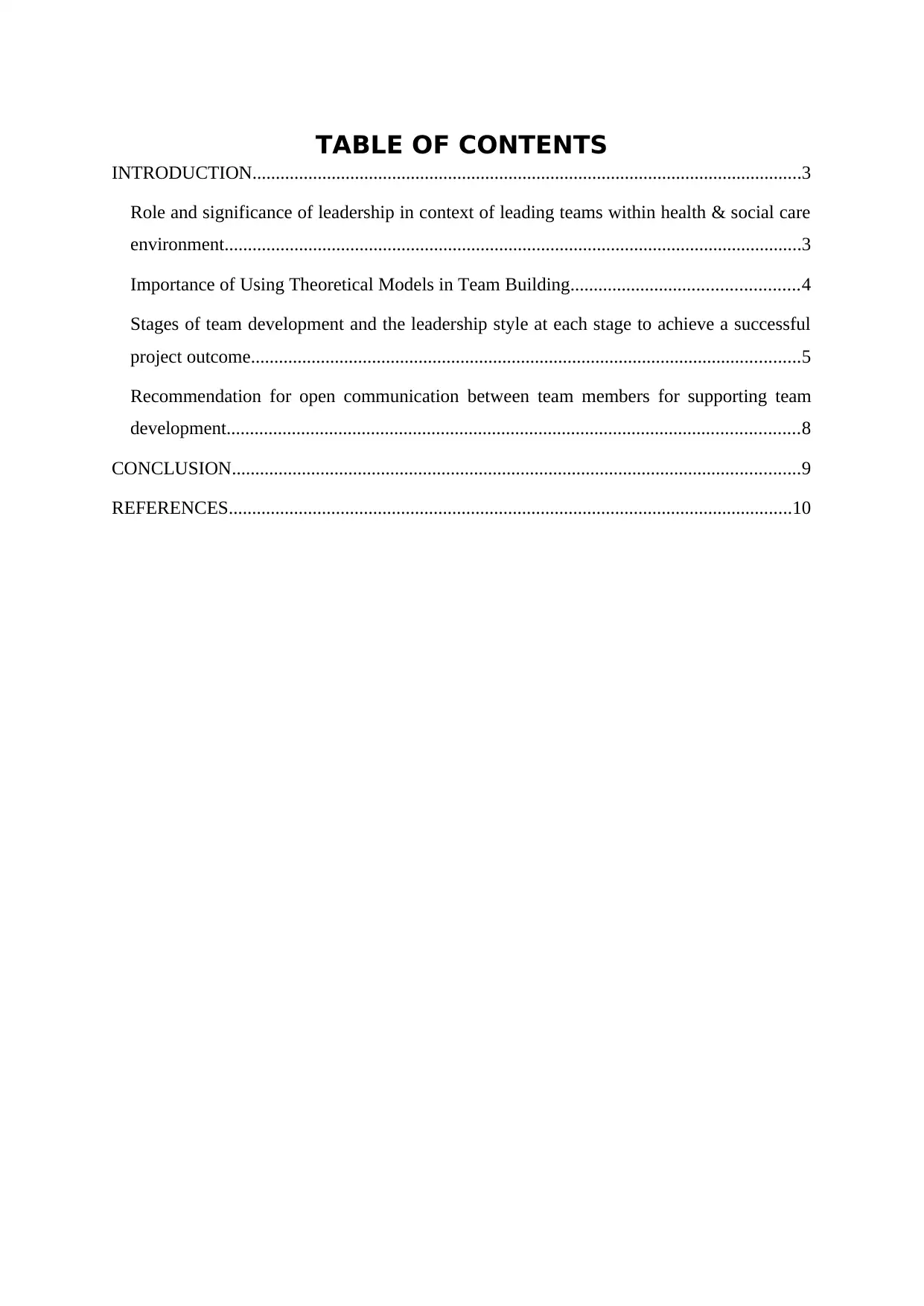
TABLE OF CONTENTS
INTRODUCTION......................................................................................................................3
Role and significance of leadership in context of leading teams within health & social care
environment............................................................................................................................3
Importance of Using Theoretical Models in Team Building.................................................4
Stages of team development and the leadership style at each stage to achieve a successful
project outcome......................................................................................................................5
Recommendation for open communication between team members for supporting team
development...........................................................................................................................8
CONCLUSION..........................................................................................................................9
REFERENCES.........................................................................................................................10
INTRODUCTION......................................................................................................................3
Role and significance of leadership in context of leading teams within health & social care
environment............................................................................................................................3
Importance of Using Theoretical Models in Team Building.................................................4
Stages of team development and the leadership style at each stage to achieve a successful
project outcome......................................................................................................................5
Recommendation for open communication between team members for supporting team
development...........................................................................................................................8
CONCLUSION..........................................................................................................................9
REFERENCES.........................................................................................................................10
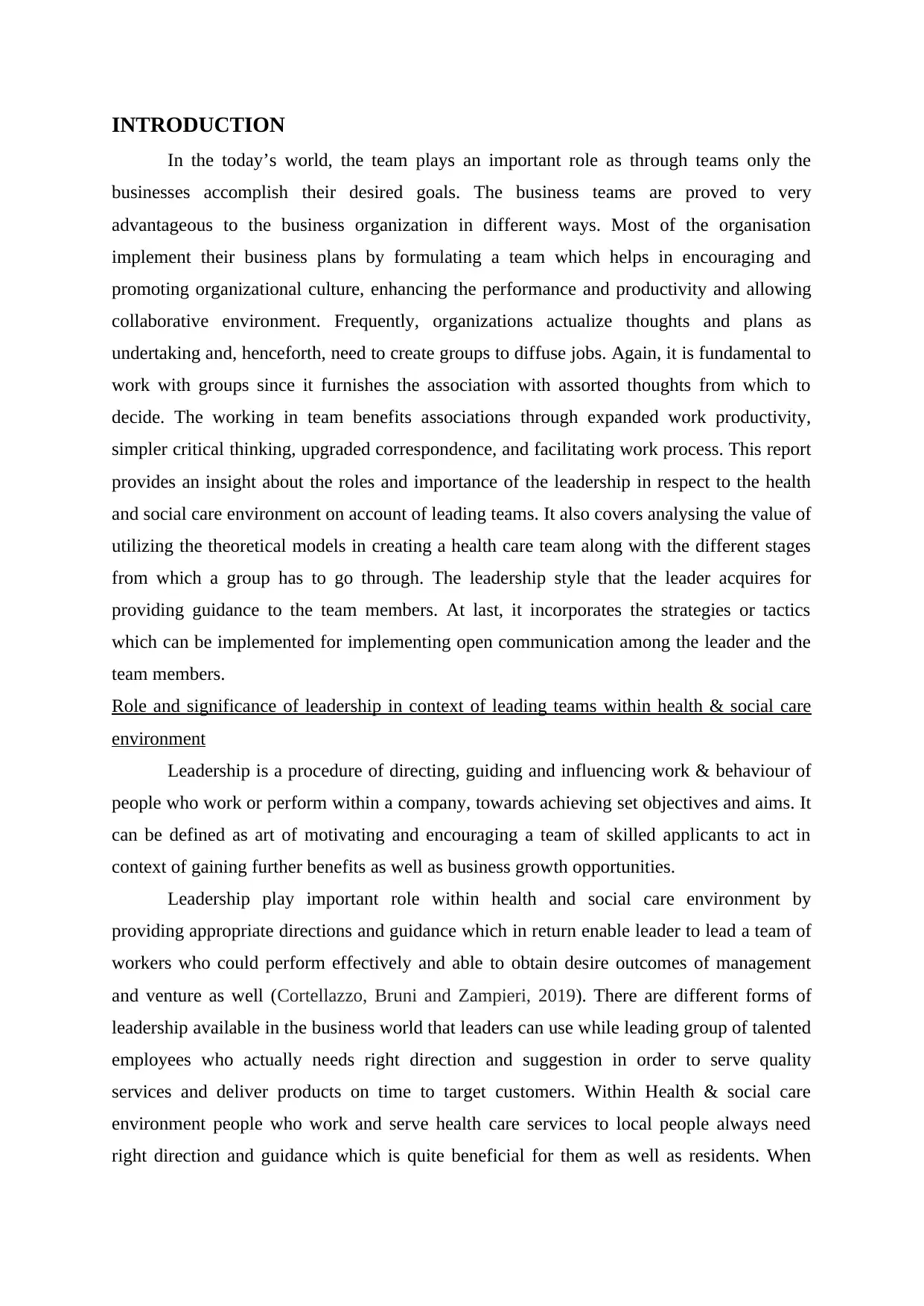
INTRODUCTION
In the today’s world, the team plays an important role as through teams only the
businesses accomplish their desired goals. The business teams are proved to very
advantageous to the business organization in different ways. Most of the organisation
implement their business plans by formulating a team which helps in encouraging and
promoting organizational culture, enhancing the performance and productivity and allowing
collaborative environment. Frequently, organizations actualize thoughts and plans as
undertaking and, henceforth, need to create groups to diffuse jobs. Again, it is fundamental to
work with groups since it furnishes the association with assorted thoughts from which to
decide. The working in team benefits associations through expanded work productivity,
simpler critical thinking, upgraded correspondence, and facilitating work process. This report
provides an insight about the roles and importance of the leadership in respect to the health
and social care environment on account of leading teams. It also covers analysing the value of
utilizing the theoretical models in creating a health care team along with the different stages
from which a group has to go through. The leadership style that the leader acquires for
providing guidance to the team members. At last, it incorporates the strategies or tactics
which can be implemented for implementing open communication among the leader and the
team members.
Role and significance of leadership in context of leading teams within health & social care
environment
Leadership is a procedure of directing, guiding and influencing work & behaviour of
people who work or perform within a company, towards achieving set objectives and aims. It
can be defined as art of motivating and encouraging a team of skilled applicants to act in
context of gaining further benefits as well as business growth opportunities.
Leadership play important role within health and social care environment by
providing appropriate directions and guidance which in return enable leader to lead a team of
workers who could perform effectively and able to obtain desire outcomes of management
and venture as well (Cortellazzo, Bruni and Zampieri, 2019). There are different forms of
leadership available in the business world that leaders can use while leading group of talented
employees who actually needs right direction and suggestion in order to serve quality
services and deliver products on time to target customers. Within Health & social care
environment people who work and serve health care services to local people always need
right direction and guidance which is quite beneficial for them as well as residents. When
In the today’s world, the team plays an important role as through teams only the
businesses accomplish their desired goals. The business teams are proved to very
advantageous to the business organization in different ways. Most of the organisation
implement their business plans by formulating a team which helps in encouraging and
promoting organizational culture, enhancing the performance and productivity and allowing
collaborative environment. Frequently, organizations actualize thoughts and plans as
undertaking and, henceforth, need to create groups to diffuse jobs. Again, it is fundamental to
work with groups since it furnishes the association with assorted thoughts from which to
decide. The working in team benefits associations through expanded work productivity,
simpler critical thinking, upgraded correspondence, and facilitating work process. This report
provides an insight about the roles and importance of the leadership in respect to the health
and social care environment on account of leading teams. It also covers analysing the value of
utilizing the theoretical models in creating a health care team along with the different stages
from which a group has to go through. The leadership style that the leader acquires for
providing guidance to the team members. At last, it incorporates the strategies or tactics
which can be implemented for implementing open communication among the leader and the
team members.
Role and significance of leadership in context of leading teams within health & social care
environment
Leadership is a procedure of directing, guiding and influencing work & behaviour of
people who work or perform within a company, towards achieving set objectives and aims. It
can be defined as art of motivating and encouraging a team of skilled applicants to act in
context of gaining further benefits as well as business growth opportunities.
Leadership play important role within health and social care environment by
providing appropriate directions and guidance which in return enable leader to lead a team of
workers who could perform effectively and able to obtain desire outcomes of management
and venture as well (Cortellazzo, Bruni and Zampieri, 2019). There are different forms of
leadership available in the business world that leaders can use while leading group of talented
employees who actually needs right direction and suggestion in order to serve quality
services and deliver products on time to target customers. Within Health & social care
environment people who work and serve health care services to local people always need
right direction and guidance which is quite beneficial for them as well as residents. When
⊘ This is a preview!⊘
Do you want full access?
Subscribe today to unlock all pages.

Trusted by 1+ million students worldwide
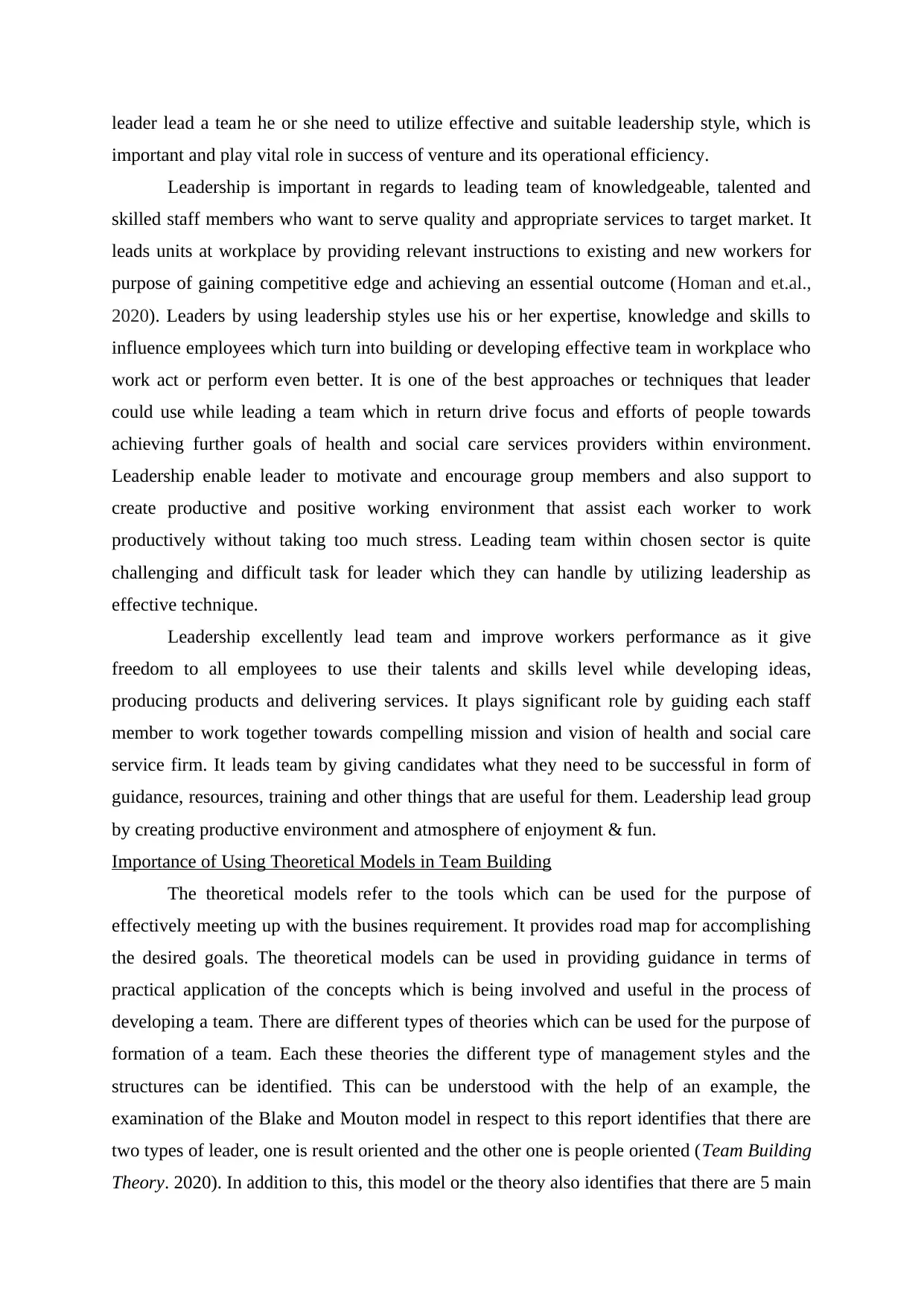
leader lead a team he or she need to utilize effective and suitable leadership style, which is
important and play vital role in success of venture and its operational efficiency.
Leadership is important in regards to leading team of knowledgeable, talented and
skilled staff members who want to serve quality and appropriate services to target market. It
leads units at workplace by providing relevant instructions to existing and new workers for
purpose of gaining competitive edge and achieving an essential outcome (Homan and et.al.,
2020). Leaders by using leadership styles use his or her expertise, knowledge and skills to
influence employees which turn into building or developing effective team in workplace who
work act or perform even better. It is one of the best approaches or techniques that leader
could use while leading a team which in return drive focus and efforts of people towards
achieving further goals of health and social care services providers within environment.
Leadership enable leader to motivate and encourage group members and also support to
create productive and positive working environment that assist each worker to work
productively without taking too much stress. Leading team within chosen sector is quite
challenging and difficult task for leader which they can handle by utilizing leadership as
effective technique.
Leadership excellently lead team and improve workers performance as it give
freedom to all employees to use their talents and skills level while developing ideas,
producing products and delivering services. It plays significant role by guiding each staff
member to work together towards compelling mission and vision of health and social care
service firm. It leads team by giving candidates what they need to be successful in form of
guidance, resources, training and other things that are useful for them. Leadership lead group
by creating productive environment and atmosphere of enjoyment & fun.
Importance of Using Theoretical Models in Team Building
The theoretical models refer to the tools which can be used for the purpose of
effectively meeting up with the busines requirement. It provides road map for accomplishing
the desired goals. The theoretical models can be used in providing guidance in terms of
practical application of the concepts which is being involved and useful in the process of
developing a team. There are different types of theories which can be used for the purpose of
formation of a team. Each these theories the different type of management styles and the
structures can be identified. This can be understood with the help of an example, the
examination of the Blake and Mouton model in respect to this report identifies that there are
two types of leader, one is result oriented and the other one is people oriented (Team Building
Theory. 2020). In addition to this, this model or the theory also identifies that there are 5 main
important and play vital role in success of venture and its operational efficiency.
Leadership is important in regards to leading team of knowledgeable, talented and
skilled staff members who want to serve quality and appropriate services to target market. It
leads units at workplace by providing relevant instructions to existing and new workers for
purpose of gaining competitive edge and achieving an essential outcome (Homan and et.al.,
2020). Leaders by using leadership styles use his or her expertise, knowledge and skills to
influence employees which turn into building or developing effective team in workplace who
work act or perform even better. It is one of the best approaches or techniques that leader
could use while leading a team which in return drive focus and efforts of people towards
achieving further goals of health and social care services providers within environment.
Leadership enable leader to motivate and encourage group members and also support to
create productive and positive working environment that assist each worker to work
productively without taking too much stress. Leading team within chosen sector is quite
challenging and difficult task for leader which they can handle by utilizing leadership as
effective technique.
Leadership excellently lead team and improve workers performance as it give
freedom to all employees to use their talents and skills level while developing ideas,
producing products and delivering services. It plays significant role by guiding each staff
member to work together towards compelling mission and vision of health and social care
service firm. It leads team by giving candidates what they need to be successful in form of
guidance, resources, training and other things that are useful for them. Leadership lead group
by creating productive environment and atmosphere of enjoyment & fun.
Importance of Using Theoretical Models in Team Building
The theoretical models refer to the tools which can be used for the purpose of
effectively meeting up with the busines requirement. It provides road map for accomplishing
the desired goals. The theoretical models can be used in providing guidance in terms of
practical application of the concepts which is being involved and useful in the process of
developing a team. There are different types of theories which can be used for the purpose of
formation of a team. Each these theories the different type of management styles and the
structures can be identified. This can be understood with the help of an example, the
examination of the Blake and Mouton model in respect to this report identifies that there are
two types of leader, one is result oriented and the other one is people oriented (Team Building
Theory. 2020). In addition to this, this model or the theory also identifies that there are 5 main
Paraphrase This Document
Need a fresh take? Get an instant paraphrase of this document with our AI Paraphraser
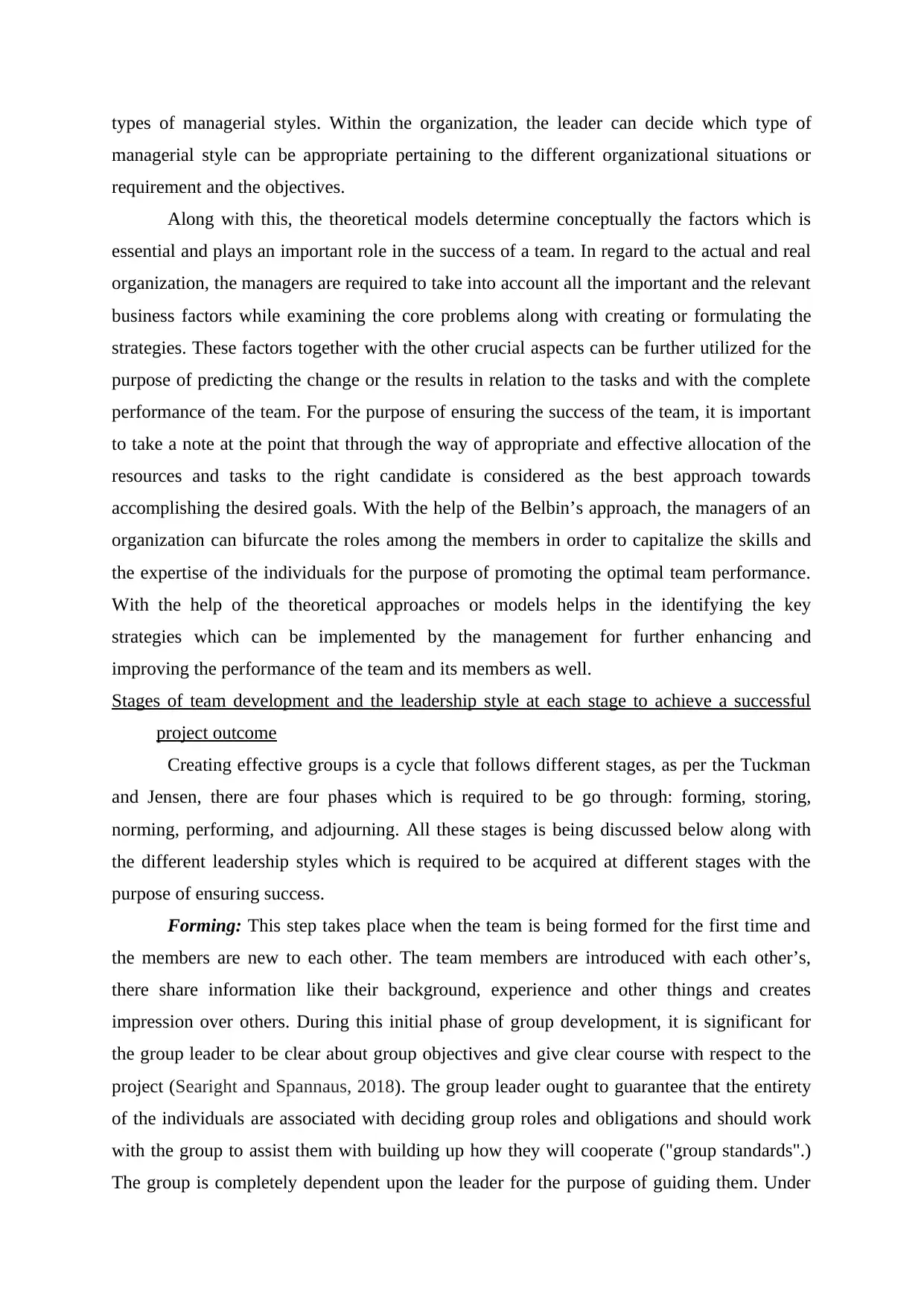
types of managerial styles. Within the organization, the leader can decide which type of
managerial style can be appropriate pertaining to the different organizational situations or
requirement and the objectives.
Along with this, the theoretical models determine conceptually the factors which is
essential and plays an important role in the success of a team. In regard to the actual and real
organization, the managers are required to take into account all the important and the relevant
business factors while examining the core problems along with creating or formulating the
strategies. These factors together with the other crucial aspects can be further utilized for the
purpose of predicting the change or the results in relation to the tasks and with the complete
performance of the team. For the purpose of ensuring the success of the team, it is important
to take a note at the point that through the way of appropriate and effective allocation of the
resources and tasks to the right candidate is considered as the best approach towards
accomplishing the desired goals. With the help of the Belbin’s approach, the managers of an
organization can bifurcate the roles among the members in order to capitalize the skills and
the expertise of the individuals for the purpose of promoting the optimal team performance.
With the help of the theoretical approaches or models helps in the identifying the key
strategies which can be implemented by the management for further enhancing and
improving the performance of the team and its members as well.
Stages of team development and the leadership style at each stage to achieve a successful
project outcome
Creating effective groups is a cycle that follows different stages, as per the Tuckman
and Jensen, there are four phases which is required to be go through: forming, storing,
norming, performing, and adjourning. All these stages is being discussed below along with
the different leadership styles which is required to be acquired at different stages with the
purpose of ensuring success.
Forming: This step takes place when the team is being formed for the first time and
the members are new to each other. The team members are introduced with each other’s,
there share information like their background, experience and other things and creates
impression over others. During this initial phase of group development, it is significant for
the group leader to be clear about group objectives and give clear course with respect to the
project (Searight and Spannaus, 2018). The group leader ought to guarantee that the entirety
of the individuals are associated with deciding group roles and obligations and should work
with the group to assist them with building up how they will cooperate ("group standards".)
The group is completely dependent upon the leader for the purpose of guiding them. Under
managerial style can be appropriate pertaining to the different organizational situations or
requirement and the objectives.
Along with this, the theoretical models determine conceptually the factors which is
essential and plays an important role in the success of a team. In regard to the actual and real
organization, the managers are required to take into account all the important and the relevant
business factors while examining the core problems along with creating or formulating the
strategies. These factors together with the other crucial aspects can be further utilized for the
purpose of predicting the change or the results in relation to the tasks and with the complete
performance of the team. For the purpose of ensuring the success of the team, it is important
to take a note at the point that through the way of appropriate and effective allocation of the
resources and tasks to the right candidate is considered as the best approach towards
accomplishing the desired goals. With the help of the Belbin’s approach, the managers of an
organization can bifurcate the roles among the members in order to capitalize the skills and
the expertise of the individuals for the purpose of promoting the optimal team performance.
With the help of the theoretical approaches or models helps in the identifying the key
strategies which can be implemented by the management for further enhancing and
improving the performance of the team and its members as well.
Stages of team development and the leadership style at each stage to achieve a successful
project outcome
Creating effective groups is a cycle that follows different stages, as per the Tuckman
and Jensen, there are four phases which is required to be go through: forming, storing,
norming, performing, and adjourning. All these stages is being discussed below along with
the different leadership styles which is required to be acquired at different stages with the
purpose of ensuring success.
Forming: This step takes place when the team is being formed for the first time and
the members are new to each other. The team members are introduced with each other’s,
there share information like their background, experience and other things and creates
impression over others. During this initial phase of group development, it is significant for
the group leader to be clear about group objectives and give clear course with respect to the
project (Searight and Spannaus, 2018). The group leader ought to guarantee that the entirety
of the individuals are associated with deciding group roles and obligations and should work
with the group to assist them with building up how they will cooperate ("group standards".)
The group is completely dependent upon the leader for the purpose of guiding them. Under
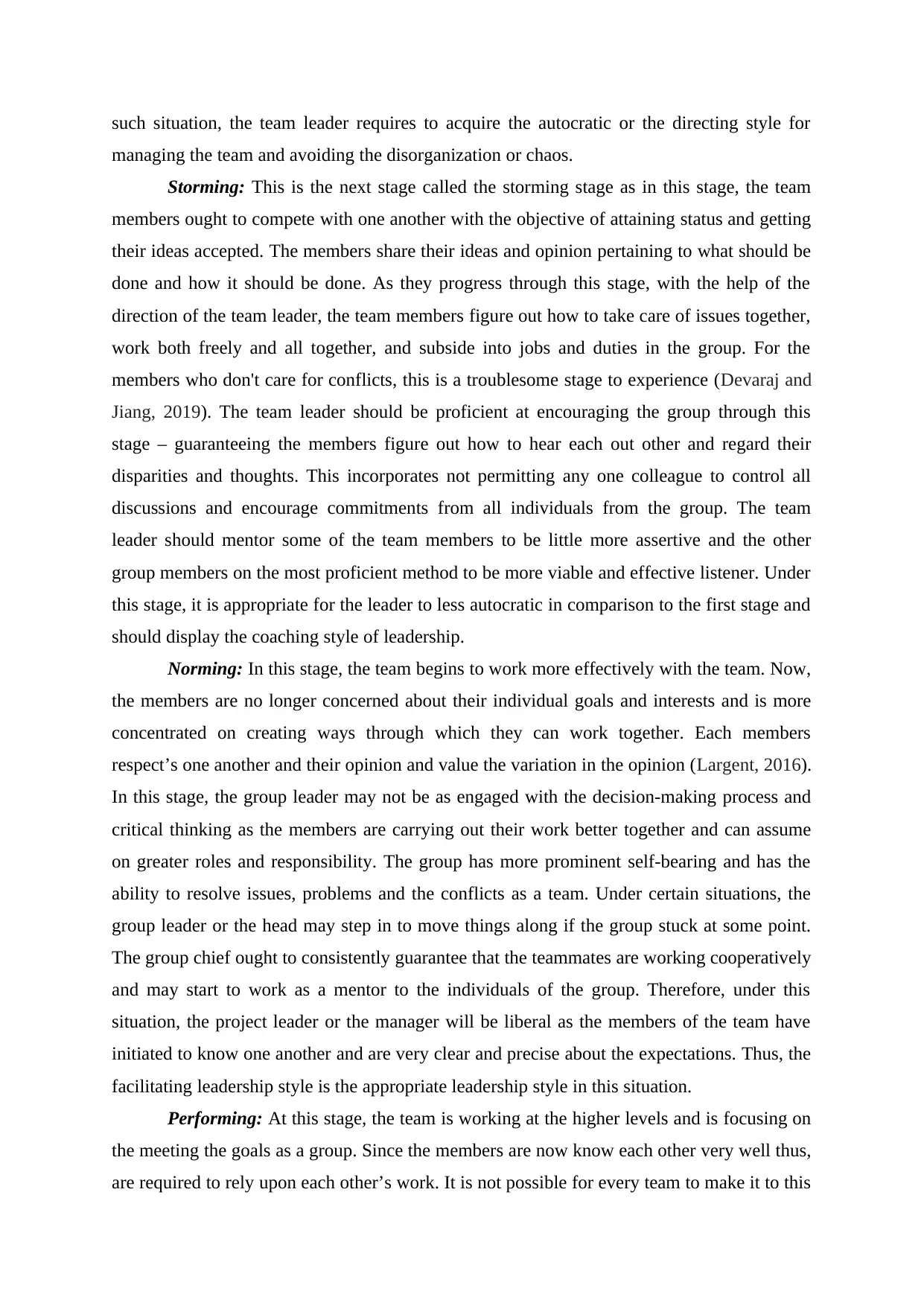
such situation, the team leader requires to acquire the autocratic or the directing style for
managing the team and avoiding the disorganization or chaos.
Storming: This is the next stage called the storming stage as in this stage, the team
members ought to compete with one another with the objective of attaining status and getting
their ideas accepted. The members share their ideas and opinion pertaining to what should be
done and how it should be done. As they progress through this stage, with the help of the
direction of the team leader, the team members figure out how to take care of issues together,
work both freely and all together, and subside into jobs and duties in the group. For the
members who don't care for conflicts, this is a troublesome stage to experience (Devaraj and
Jiang, 2019). The team leader should be proficient at encouraging the group through this
stage – guaranteeing the members figure out how to hear each out other and regard their
disparities and thoughts. This incorporates not permitting any one colleague to control all
discussions and encourage commitments from all individuals from the group. The team
leader should mentor some of the team members to be little more assertive and the other
group members on the most proficient method to be more viable and effective listener. Under
this stage, it is appropriate for the leader to less autocratic in comparison to the first stage and
should display the coaching style of leadership.
Norming: In this stage, the team begins to work more effectively with the team. Now,
the members are no longer concerned about their individual goals and interests and is more
concentrated on creating ways through which they can work together. Each members
respect’s one another and their opinion and value the variation in the opinion (Largent, 2016).
In this stage, the group leader may not be as engaged with the decision-making process and
critical thinking as the members are carrying out their work better together and can assume
on greater roles and responsibility. The group has more prominent self-bearing and has the
ability to resolve issues, problems and the conflicts as a team. Under certain situations, the
group leader or the head may step in to move things along if the group stuck at some point.
The group chief ought to consistently guarantee that the teammates are working cooperatively
and may start to work as a mentor to the individuals of the group. Therefore, under this
situation, the project leader or the manager will be liberal as the members of the team have
initiated to know one another and are very clear and precise about the expectations. Thus, the
facilitating leadership style is the appropriate leadership style in this situation.
Performing: At this stage, the team is working at the higher levels and is focusing on
the meeting the goals as a group. Since the members are now know each other very well thus,
are required to rely upon each other’s work. It is not possible for every team to make it to this
managing the team and avoiding the disorganization or chaos.
Storming: This is the next stage called the storming stage as in this stage, the team
members ought to compete with one another with the objective of attaining status and getting
their ideas accepted. The members share their ideas and opinion pertaining to what should be
done and how it should be done. As they progress through this stage, with the help of the
direction of the team leader, the team members figure out how to take care of issues together,
work both freely and all together, and subside into jobs and duties in the group. For the
members who don't care for conflicts, this is a troublesome stage to experience (Devaraj and
Jiang, 2019). The team leader should be proficient at encouraging the group through this
stage – guaranteeing the members figure out how to hear each out other and regard their
disparities and thoughts. This incorporates not permitting any one colleague to control all
discussions and encourage commitments from all individuals from the group. The team
leader should mentor some of the team members to be little more assertive and the other
group members on the most proficient method to be more viable and effective listener. Under
this stage, it is appropriate for the leader to less autocratic in comparison to the first stage and
should display the coaching style of leadership.
Norming: In this stage, the team begins to work more effectively with the team. Now,
the members are no longer concerned about their individual goals and interests and is more
concentrated on creating ways through which they can work together. Each members
respect’s one another and their opinion and value the variation in the opinion (Largent, 2016).
In this stage, the group leader may not be as engaged with the decision-making process and
critical thinking as the members are carrying out their work better together and can assume
on greater roles and responsibility. The group has more prominent self-bearing and has the
ability to resolve issues, problems and the conflicts as a team. Under certain situations, the
group leader or the head may step in to move things along if the group stuck at some point.
The group chief ought to consistently guarantee that the teammates are working cooperatively
and may start to work as a mentor to the individuals of the group. Therefore, under this
situation, the project leader or the manager will be liberal as the members of the team have
initiated to know one another and are very clear and precise about the expectations. Thus, the
facilitating leadership style is the appropriate leadership style in this situation.
Performing: At this stage, the team is working at the higher levels and is focusing on
the meeting the goals as a group. Since the members are now know each other very well thus,
are required to rely upon each other’s work. It is not possible for every team to make it to this
⊘ This is a preview!⊘
Do you want full access?
Subscribe today to unlock all pages.

Trusted by 1+ million students worldwide
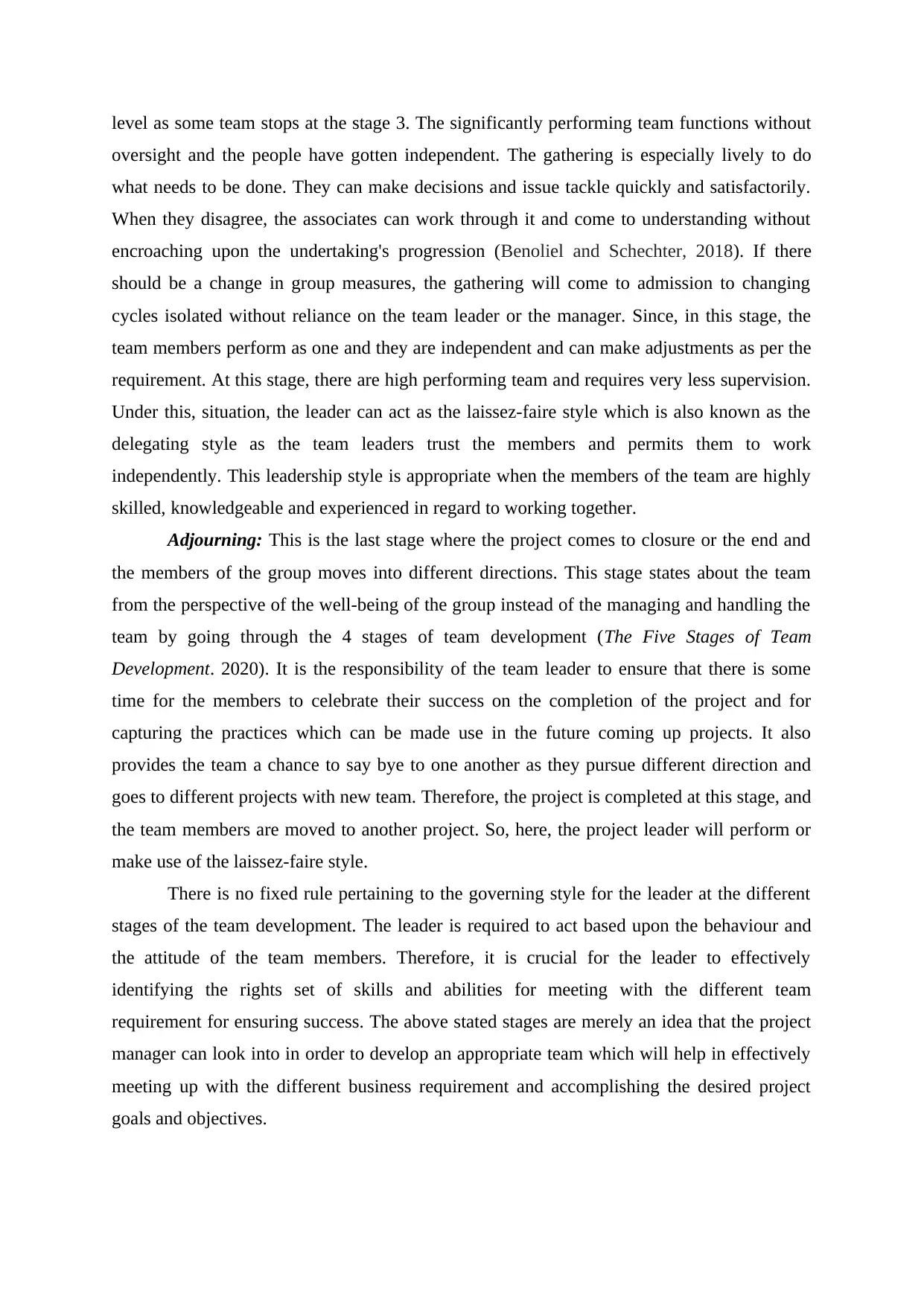
level as some team stops at the stage 3. The significantly performing team functions without
oversight and the people have gotten independent. The gathering is especially lively to do
what needs to be done. They can make decisions and issue tackle quickly and satisfactorily.
When they disagree, the associates can work through it and come to understanding without
encroaching upon the undertaking's progression (Benoliel and Schechter, 2018). If there
should be a change in group measures, the gathering will come to admission to changing
cycles isolated without reliance on the team leader or the manager. Since, in this stage, the
team members perform as one and they are independent and can make adjustments as per the
requirement. At this stage, there are high performing team and requires very less supervision.
Under this, situation, the leader can act as the laissez-faire style which is also known as the
delegating style as the team leaders trust the members and permits them to work
independently. This leadership style is appropriate when the members of the team are highly
skilled, knowledgeable and experienced in regard to working together.
Adjourning: This is the last stage where the project comes to closure or the end and
the members of the group moves into different directions. This stage states about the team
from the perspective of the well-being of the group instead of the managing and handling the
team by going through the 4 stages of team development (The Five Stages of Team
Development. 2020). It is the responsibility of the team leader to ensure that there is some
time for the members to celebrate their success on the completion of the project and for
capturing the practices which can be made use in the future coming up projects. It also
provides the team a chance to say bye to one another as they pursue different direction and
goes to different projects with new team. Therefore, the project is completed at this stage, and
the team members are moved to another project. So, here, the project leader will perform or
make use of the laissez-faire style.
There is no fixed rule pertaining to the governing style for the leader at the different
stages of the team development. The leader is required to act based upon the behaviour and
the attitude of the team members. Therefore, it is crucial for the leader to effectively
identifying the rights set of skills and abilities for meeting with the different team
requirement for ensuring success. The above stated stages are merely an idea that the project
manager can look into in order to develop an appropriate team which will help in effectively
meeting up with the different business requirement and accomplishing the desired project
goals and objectives.
oversight and the people have gotten independent. The gathering is especially lively to do
what needs to be done. They can make decisions and issue tackle quickly and satisfactorily.
When they disagree, the associates can work through it and come to understanding without
encroaching upon the undertaking's progression (Benoliel and Schechter, 2018). If there
should be a change in group measures, the gathering will come to admission to changing
cycles isolated without reliance on the team leader or the manager. Since, in this stage, the
team members perform as one and they are independent and can make adjustments as per the
requirement. At this stage, there are high performing team and requires very less supervision.
Under this, situation, the leader can act as the laissez-faire style which is also known as the
delegating style as the team leaders trust the members and permits them to work
independently. This leadership style is appropriate when the members of the team are highly
skilled, knowledgeable and experienced in regard to working together.
Adjourning: This is the last stage where the project comes to closure or the end and
the members of the group moves into different directions. This stage states about the team
from the perspective of the well-being of the group instead of the managing and handling the
team by going through the 4 stages of team development (The Five Stages of Team
Development. 2020). It is the responsibility of the team leader to ensure that there is some
time for the members to celebrate their success on the completion of the project and for
capturing the practices which can be made use in the future coming up projects. It also
provides the team a chance to say bye to one another as they pursue different direction and
goes to different projects with new team. Therefore, the project is completed at this stage, and
the team members are moved to another project. So, here, the project leader will perform or
make use of the laissez-faire style.
There is no fixed rule pertaining to the governing style for the leader at the different
stages of the team development. The leader is required to act based upon the behaviour and
the attitude of the team members. Therefore, it is crucial for the leader to effectively
identifying the rights set of skills and abilities for meeting with the different team
requirement for ensuring success. The above stated stages are merely an idea that the project
manager can look into in order to develop an appropriate team which will help in effectively
meeting up with the different business requirement and accomplishing the desired project
goals and objectives.
Paraphrase This Document
Need a fresh take? Get an instant paraphrase of this document with our AI Paraphraser
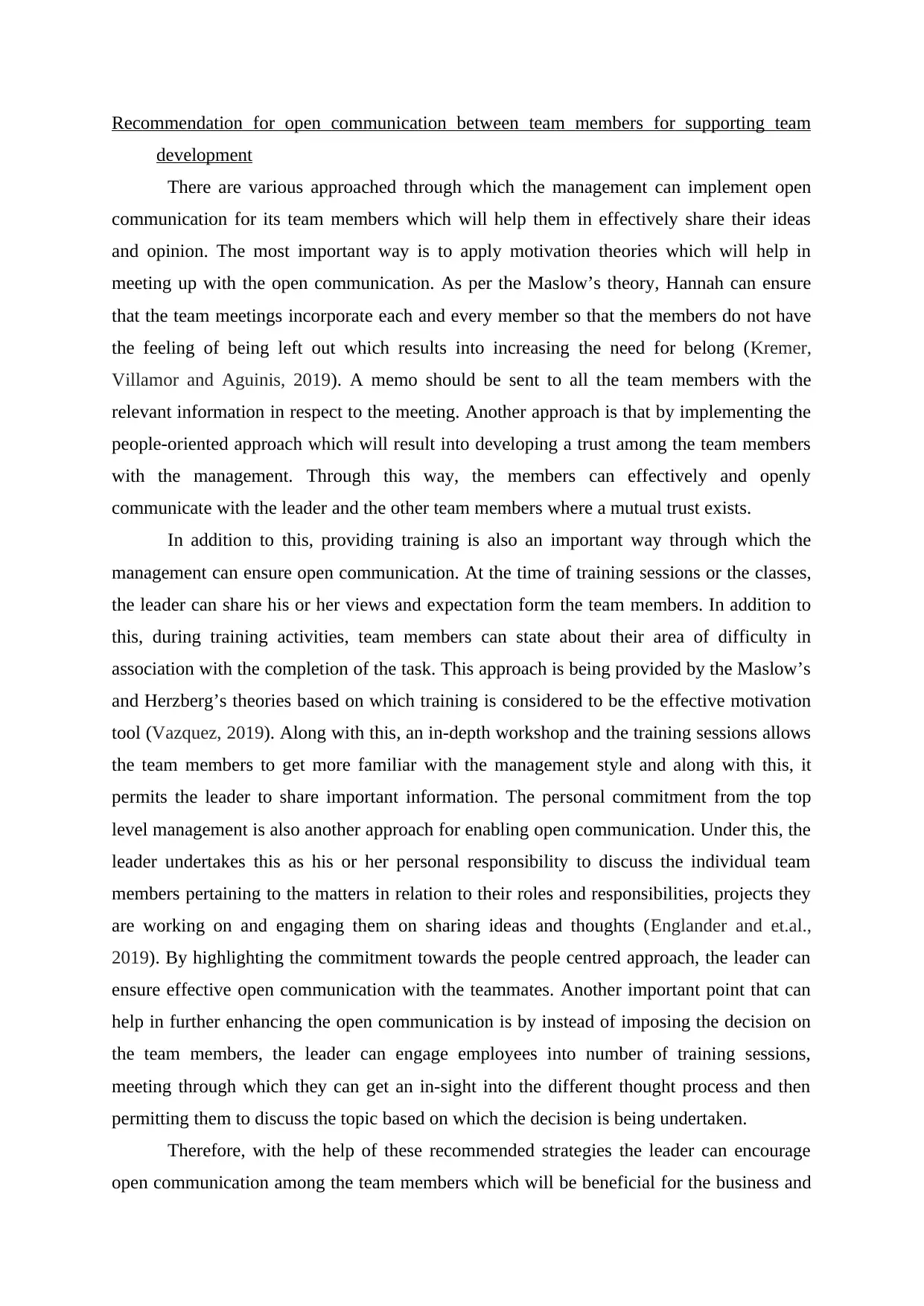
Recommendation for open communication between team members for supporting team
development
There are various approached through which the management can implement open
communication for its team members which will help them in effectively share their ideas
and opinion. The most important way is to apply motivation theories which will help in
meeting up with the open communication. As per the Maslow’s theory, Hannah can ensure
that the team meetings incorporate each and every member so that the members do not have
the feeling of being left out which results into increasing the need for belong (Kremer,
Villamor and Aguinis, 2019). A memo should be sent to all the team members with the
relevant information in respect to the meeting. Another approach is that by implementing the
people-oriented approach which will result into developing a trust among the team members
with the management. Through this way, the members can effectively and openly
communicate with the leader and the other team members where a mutual trust exists.
In addition to this, providing training is also an important way through which the
management can ensure open communication. At the time of training sessions or the classes,
the leader can share his or her views and expectation form the team members. In addition to
this, during training activities, team members can state about their area of difficulty in
association with the completion of the task. This approach is being provided by the Maslow’s
and Herzberg’s theories based on which training is considered to be the effective motivation
tool (Vazquez, 2019). Along with this, an in-depth workshop and the training sessions allows
the team members to get more familiar with the management style and along with this, it
permits the leader to share important information. The personal commitment from the top
level management is also another approach for enabling open communication. Under this, the
leader undertakes this as his or her personal responsibility to discuss the individual team
members pertaining to the matters in relation to their roles and responsibilities, projects they
are working on and engaging them on sharing ideas and thoughts (Englander and et.al.,
2019). By highlighting the commitment towards the people centred approach, the leader can
ensure effective open communication with the teammates. Another important point that can
help in further enhancing the open communication is by instead of imposing the decision on
the team members, the leader can engage employees into number of training sessions,
meeting through which they can get an in-sight into the different thought process and then
permitting them to discuss the topic based on which the decision is being undertaken.
Therefore, with the help of these recommended strategies the leader can encourage
open communication among the team members which will be beneficial for the business and
development
There are various approached through which the management can implement open
communication for its team members which will help them in effectively share their ideas
and opinion. The most important way is to apply motivation theories which will help in
meeting up with the open communication. As per the Maslow’s theory, Hannah can ensure
that the team meetings incorporate each and every member so that the members do not have
the feeling of being left out which results into increasing the need for belong (Kremer,
Villamor and Aguinis, 2019). A memo should be sent to all the team members with the
relevant information in respect to the meeting. Another approach is that by implementing the
people-oriented approach which will result into developing a trust among the team members
with the management. Through this way, the members can effectively and openly
communicate with the leader and the other team members where a mutual trust exists.
In addition to this, providing training is also an important way through which the
management can ensure open communication. At the time of training sessions or the classes,
the leader can share his or her views and expectation form the team members. In addition to
this, during training activities, team members can state about their area of difficulty in
association with the completion of the task. This approach is being provided by the Maslow’s
and Herzberg’s theories based on which training is considered to be the effective motivation
tool (Vazquez, 2019). Along with this, an in-depth workshop and the training sessions allows
the team members to get more familiar with the management style and along with this, it
permits the leader to share important information. The personal commitment from the top
level management is also another approach for enabling open communication. Under this, the
leader undertakes this as his or her personal responsibility to discuss the individual team
members pertaining to the matters in relation to their roles and responsibilities, projects they
are working on and engaging them on sharing ideas and thoughts (Englander and et.al.,
2019). By highlighting the commitment towards the people centred approach, the leader can
ensure effective open communication with the teammates. Another important point that can
help in further enhancing the open communication is by instead of imposing the decision on
the team members, the leader can engage employees into number of training sessions,
meeting through which they can get an in-sight into the different thought process and then
permitting them to discuss the topic based on which the decision is being undertaken.
Therefore, with the help of these recommended strategies the leader can encourage
open communication among the team members which will be beneficial for the business and
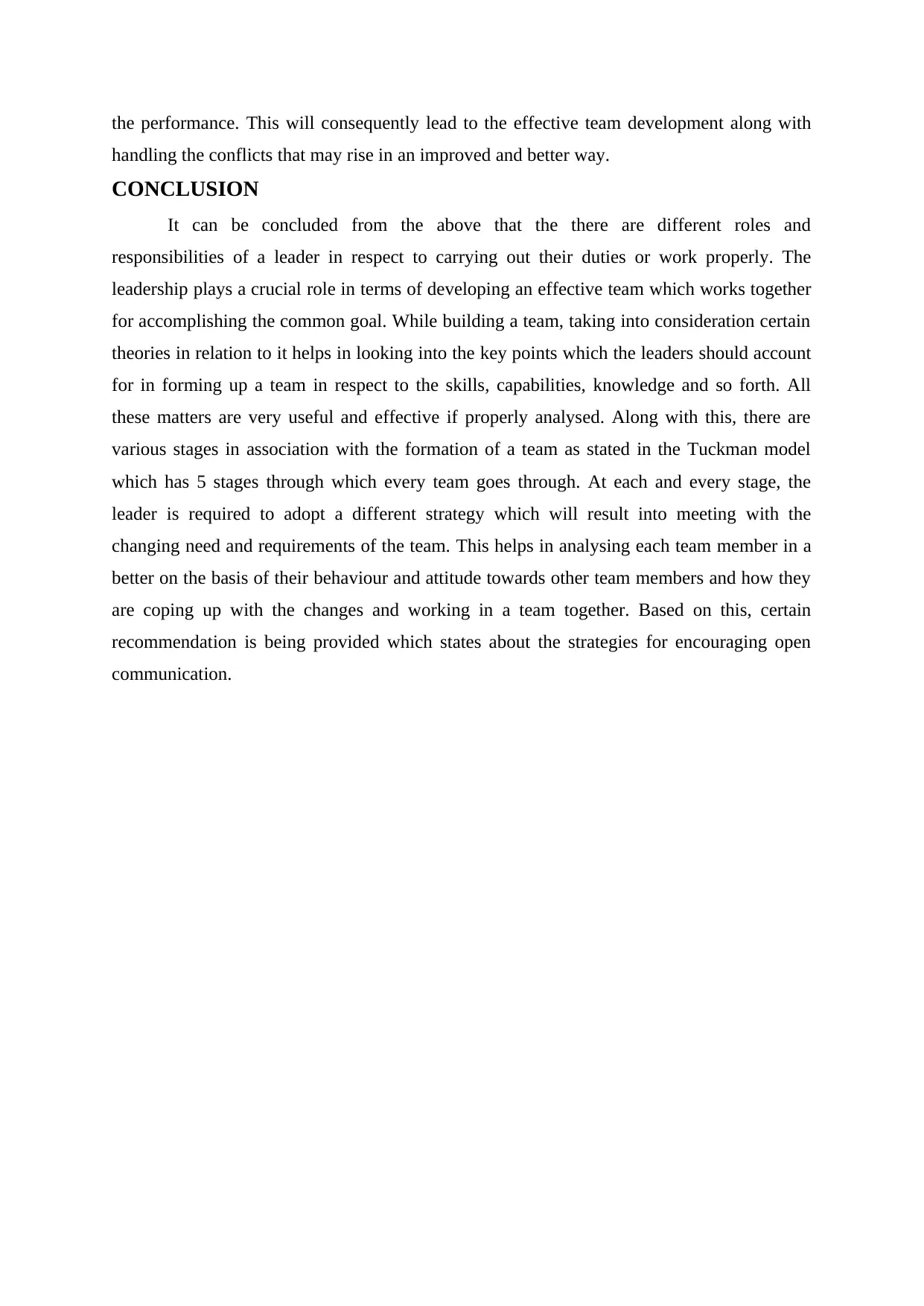
the performance. This will consequently lead to the effective team development along with
handling the conflicts that may rise in an improved and better way.
CONCLUSION
It can be concluded from the above that the there are different roles and
responsibilities of a leader in respect to carrying out their duties or work properly. The
leadership plays a crucial role in terms of developing an effective team which works together
for accomplishing the common goal. While building a team, taking into consideration certain
theories in relation to it helps in looking into the key points which the leaders should account
for in forming up a team in respect to the skills, capabilities, knowledge and so forth. All
these matters are very useful and effective if properly analysed. Along with this, there are
various stages in association with the formation of a team as stated in the Tuckman model
which has 5 stages through which every team goes through. At each and every stage, the
leader is required to adopt a different strategy which will result into meeting with the
changing need and requirements of the team. This helps in analysing each team member in a
better on the basis of their behaviour and attitude towards other team members and how they
are coping up with the changes and working in a team together. Based on this, certain
recommendation is being provided which states about the strategies for encouraging open
communication.
handling the conflicts that may rise in an improved and better way.
CONCLUSION
It can be concluded from the above that the there are different roles and
responsibilities of a leader in respect to carrying out their duties or work properly. The
leadership plays a crucial role in terms of developing an effective team which works together
for accomplishing the common goal. While building a team, taking into consideration certain
theories in relation to it helps in looking into the key points which the leaders should account
for in forming up a team in respect to the skills, capabilities, knowledge and so forth. All
these matters are very useful and effective if properly analysed. Along with this, there are
various stages in association with the formation of a team as stated in the Tuckman model
which has 5 stages through which every team goes through. At each and every stage, the
leader is required to adopt a different strategy which will result into meeting with the
changing need and requirements of the team. This helps in analysing each team member in a
better on the basis of their behaviour and attitude towards other team members and how they
are coping up with the changes and working in a team together. Based on this, certain
recommendation is being provided which states about the strategies for encouraging open
communication.
⊘ This is a preview!⊘
Do you want full access?
Subscribe today to unlock all pages.

Trusted by 1+ million students worldwide
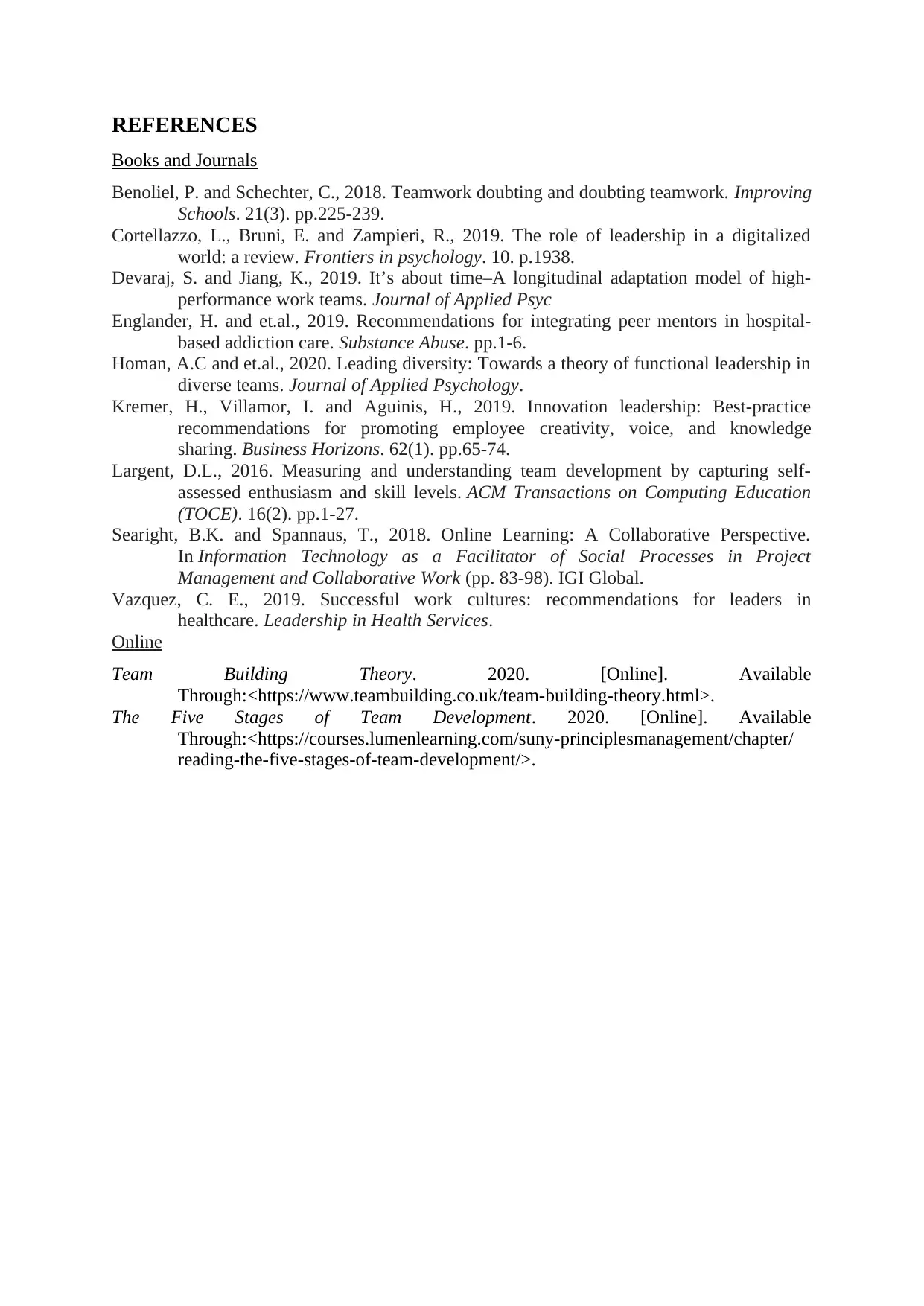
REFERENCES
Books and Journals
Benoliel, P. and Schechter, C., 2018. Teamwork doubting and doubting teamwork. Improving
Schools. 21(3). pp.225-239.
Cortellazzo, L., Bruni, E. and Zampieri, R., 2019. The role of leadership in a digitalized
world: a review. Frontiers in psychology. 10. p.1938.
Devaraj, S. and Jiang, K., 2019. It’s about time–A longitudinal adaptation model of high-
performance work teams. Journal of Applied Psyc
Englander, H. and et.al., 2019. Recommendations for integrating peer mentors in hospital-
based addiction care. Substance Abuse. pp.1-6.
Homan, A.C and et.al., 2020. Leading diversity: Towards a theory of functional leadership in
diverse teams. Journal of Applied Psychology.
Kremer, H., Villamor, I. and Aguinis, H., 2019. Innovation leadership: Best-practice
recommendations for promoting employee creativity, voice, and knowledge
sharing. Business Horizons. 62(1). pp.65-74.
Largent, D.L., 2016. Measuring and understanding team development by capturing self-
assessed enthusiasm and skill levels. ACM Transactions on Computing Education
(TOCE). 16(2). pp.1-27.
Searight, B.K. and Spannaus, T., 2018. Online Learning: A Collaborative Perspective.
In Information Technology as a Facilitator of Social Processes in Project
Management and Collaborative Work (pp. 83-98). IGI Global.
Vazquez, C. E., 2019. Successful work cultures: recommendations for leaders in
healthcare. Leadership in Health Services.
Online
Team Building Theory. 2020. [Online]. Available
Through:<https://www.teambuilding.co.uk/team-building-theory.html>.
The Five Stages of Team Development. 2020. [Online]. Available
Through:<https://courses.lumenlearning.com/suny-principlesmanagement/chapter/
reading-the-five-stages-of-team-development/>.
Books and Journals
Benoliel, P. and Schechter, C., 2018. Teamwork doubting and doubting teamwork. Improving
Schools. 21(3). pp.225-239.
Cortellazzo, L., Bruni, E. and Zampieri, R., 2019. The role of leadership in a digitalized
world: a review. Frontiers in psychology. 10. p.1938.
Devaraj, S. and Jiang, K., 2019. It’s about time–A longitudinal adaptation model of high-
performance work teams. Journal of Applied Psyc
Englander, H. and et.al., 2019. Recommendations for integrating peer mentors in hospital-
based addiction care. Substance Abuse. pp.1-6.
Homan, A.C and et.al., 2020. Leading diversity: Towards a theory of functional leadership in
diverse teams. Journal of Applied Psychology.
Kremer, H., Villamor, I. and Aguinis, H., 2019. Innovation leadership: Best-practice
recommendations for promoting employee creativity, voice, and knowledge
sharing. Business Horizons. 62(1). pp.65-74.
Largent, D.L., 2016. Measuring and understanding team development by capturing self-
assessed enthusiasm and skill levels. ACM Transactions on Computing Education
(TOCE). 16(2). pp.1-27.
Searight, B.K. and Spannaus, T., 2018. Online Learning: A Collaborative Perspective.
In Information Technology as a Facilitator of Social Processes in Project
Management and Collaborative Work (pp. 83-98). IGI Global.
Vazquez, C. E., 2019. Successful work cultures: recommendations for leaders in
healthcare. Leadership in Health Services.
Online
Team Building Theory. 2020. [Online]. Available
Through:<https://www.teambuilding.co.uk/team-building-theory.html>.
The Five Stages of Team Development. 2020. [Online]. Available
Through:<https://courses.lumenlearning.com/suny-principlesmanagement/chapter/
reading-the-five-stages-of-team-development/>.
1 out of 10
Related Documents
Your All-in-One AI-Powered Toolkit for Academic Success.
+13062052269
info@desklib.com
Available 24*7 on WhatsApp / Email
![[object Object]](/_next/static/media/star-bottom.7253800d.svg)
Unlock your academic potential
Copyright © 2020–2025 A2Z Services. All Rights Reserved. Developed and managed by ZUCOL.


